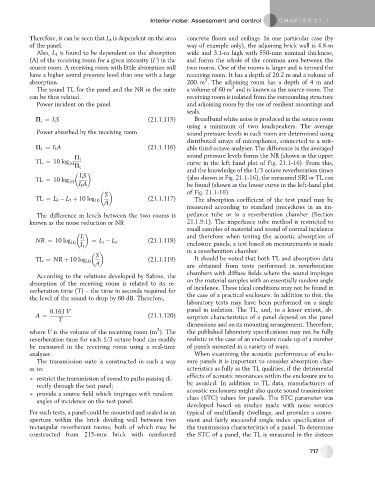Page 706 - Automotive Engineering Powertrain Chassis System and Vehicle Body
P. 706
Interior noise: Assessment and control C HAPTER 21.1
Therefore, it can be seen that L t is dependent on the area concrete floors and ceilings. In one particular case (by
of the panel. way of example only), the adjoining brick wall is 4.8-m
Also, L t is found to be dependent on the absorption wide and 3.1-m high with 550-mm nominal thickness,
(A) of the receiving room for a given intensity (I ) in the and forms the whole of the common area between the
source room. A receiving room with little absorption will two rooms. One of the rooms is larger and is termed the
have a higher sound pressure level than one with a large receiving room. It has a depth of 20.2 m and a volume of
3
absorption. 200 m . The adjoining room has a depth of 4 m and
3
The sound TL for the panel and the NR in the suite a volume of 60 m and is known as the source room. The
can be thus related. receiving room is isolated from the surrounding structure
Power incident on the panel and adjoining room by the use of resilient mountings and
seals.
P i ¼ I i S (21.1.115) Broadband white noise is produced in the source room
using a minimum of two loudspeakers. The average
Power absorbed by the receiving room sound pressure levels in each room are determined using
distributed arrays of microphones, connected to a suit-
P t ¼ I t A (21.1.116) able third octave analyser. The difference in the averaged
sound pressure levels forms the NR (shown as the upper
P i
TL ¼ 10 log 10 curve in the left hand plot of Fig. 21.1-16). From this,
P t
and the knowledge of the 1/3 octave reverberation times
I i S
TL ¼ 10 log 10 (also shown in Fig. 21.1-16), the measured SRI or TL can
I t A be found (shown as the lower curve in the left-hand plot
S of Fig. 21.1-16).
TL ¼ L i L t þ 10 log 10 (21.1.117) The absorption coefficient of the test panel may be
A
measured according to standard procedures in an im-
The difference in levels between the two rooms is pedance tube or in a reverberation chamber (Section
known as the noise reduction or NR 21.1.9.1). The impedance tube method is restricted to
small samples of material and sound of normal incidence
I i and therefore when testing the acoustic absorption of
NR ¼ 10 log 10 ¼ L i L t (21.1.118)
I t enclosure panels, a test based on measurements is made
in a reverberation chamber.
S
TL ¼ NR þ 10 log 10 (21.1.119) It should be noted that both TL and absorption data
A are obtained from tests performed in reverberation
chambers with diffuse fields where the sound impinges
According to the relations developed by Sabine, the
absorption of the receiving room is related to its re- on the material samples with an essentially random angle
verberation time (T) – the time in seconds required for of incidence. These ideal conditions may not be found in
the level of the sound to drop by 60 dB. Therefore, the case of a practical enclosure. In addition to this, the
laboratory tests may have been performed on a single
0:161 V panel in isolation. The TL, and, to a lesser extent, ab-
A ¼ (21.1.120) sorption characteristics of a panel depend on the panel
T
dimensions and on its mounting arrangement. Therefore,
3
where V is the volume of the receiving room (m ). The the published laboratory specifications may not be fully
reverberation time for each 1/3 octave band can readily realistic in the case of an enclosure made up of a number
be measured in the receiving room using a real-time of panels mounted in a variety of ways.
analyser. When examining the acoustic performance of enclo-
The transmission suite is constructed in such a way sure panels it is important to consider absorption char-
as to: acteristics as fully as the TL qualities, if the detrimental
effects of acoustic resonances within the enclosure are to
restrict the transmission of sound to paths passing di-
rectly through the test panel; be avoided. In addition to TL data, manufacturers of
acoustic enclosures might also quote sound transmission
provide a source field which impinges with random
angles of incidence on the test panel. class (STC) values for panels. The STC parameter was
developed based on studies made with noise sources
For such tests, a panel could be mounted and sealed in an typical of multifamily dwellings, and provides a conve-
aperture within the brick dividing wall between two nient and fairly successful single index specification of
rectangular reverberant rooms, both of which may be the transmission characteristics of a panel. To determine
constructed from 215-mm brick with reinforced the STC of a panel, the TL is measured in the sixteen
717

